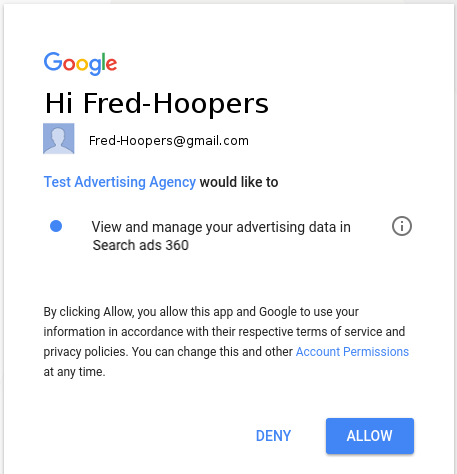Search Ads 360 API 要求所有要求都必須指定 OAuth 2.0 存取權杖進行驗證。您可以按照任何標準 OAuth 2.0 驗證工作流程產生權杖,然後將其傳遞至 Search Ads 360 API。我們建議您採用下方所述的工作流程,因為這類工作流程適合用於全自動轉換上傳和報表下載作業。
如要瞭解下列工作流程的替代方案,請參閱「針對已安裝的應用程式使用 OAuth 2.0」或「
針對伺服器對伺服器應用程式使用 OAuth 2.0」。若您使用其他工作流程,請在要求 OAuth 2.0 授權碼時,將下列值指定為 scope 參數:
https://www.googleapis.com/auth/doubleclicksearch
如果您遵循伺服器對伺服器轉送,請將服務帳戶新增為 Search Ads 360 使用者。
建議的授權工作流程
- 前往 Google API 控制台,然後選取您的專案。
如果您尚未建立 Google API 控制台專案和 OAuth 憑證,請按照「為用戶端建立 Google API 控制台專案和 OAuth 憑證」一文中的操作說明進行操作。
如要找出專案的 OAuth 用戶端 ID 和密鑰,請按照下列步驟操作:
- 開啟網路瀏覽器,然後使用登入 Google
帳戶,該帳戶具備存取 Search Ads 360 資料的權限。
這是 API 用戶端用於向 Search Ads 360 驗證的 Google 帳戶。 如果 Google 帳戶持有人離職,而您移除了帳戶的 Search Ads 360 存取權,就必須重複這項授權工作流程,並指定其他 Google 帳戶。
- 如要取得重新整理權杖,請呼叫 Search Ads 360 公用程式指令碼,如下所示:
sa360Api.py --login指令碼會引導您使用 OAuth 用戶端 ID 和密碼取得更新憑證。此重新整理權杖僅適用於您在上一個步驟中登入的 Google 帳戶。
在這個程序中,指令碼會產生網址,並指示您透過網路瀏覽器造訪該網址。
-
當瀏覽器要求您允許 OAuth 用戶端存取 Search Ads 360 資料時, 請務必顯示您稍早登入的 Google 帳戶。(如果您登入多個 Google 帳戶,系統可能會顯示其他帳戶)。

程序結束時,
sa360Api.py指令碼會輸出以半形逗號分隔的字串。第一個值是您提供的客戶端 ID,第二個值是您提供的客戶端密鑰,第三個值則是重新整理權杖。在以下範例輸出內容中,更新權杖以粗體文字顯示:
123456789123.apps.googleusercontent.com,ABCDEFGHIJKLMNOPQR_abcdef,1/HIJklM01OPQR23NOP456rst890uvw - 將用戶端 ID、用戶端密鑰和更新權杖儲存在後端資料庫或其他可供應用程式存取的安全位置。
如果您打算使用
sa360Api.py將 JSON 要求範例傳送至 Search Ads 360 API,請將整個逗號分隔字串存放在方便的位置。每次叫用指令碼時,您都會將整個字串做為參數傳遞。 - 在應用程式中加入程式碼,執行下列操作:
- 使用用戶端 ID、用戶端密碼和更新憑證,取得新的 OAuth 2.0 存取權杖。
- 使用新的存取權杖,將要求傳送至 Search Ads 360 API。
如果您使用的是用戶端程式庫,請參閱下一節「設定應用程式」,瞭解如何將此授權碼新增至應用程式。
如果您未使用任何用戶端程式庫,請參閱「為已安裝的應用程式使用 OAuth 2.0」,瞭解如何取得新的存取權杖。

